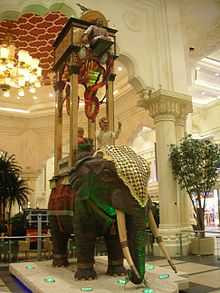Elephant clock
The elephant clock was a medieval invention by al-Jazari (1136–1206), consisting of a weight powered water clock in the form of an Asian elephant. The various elements of the clock are in the housing (howdah) on top of the elephant. They were designed to move and make a sound each half hour.
A modern full-size working reproduction can be found as a centrepiece in the Ibn Battuta Mall, a shopping mall in Dubai, United Arab Emirates. Another working reproduction can be seen outside the Musée d'Horlogerie du Locle, Château des Monts, in Le Locle, Switzerland.
In addition to its mechanical innovations, the clock itself is seen as an early example of multiculturalism represented in technology. The elephant represents the Indian and African cultures, the dragon represents Chinese culture, the phoenix represents ancient Egyptian culture, the water work represents ancient Greek culture, and the turban represents Islamic culture.[2]
Mechanism

The timing mechanism is based on a water-filled bucket hidden inside the elephant. In the bucket is a deep bowl floating in the water, but with a small hole in the centre. The bowl takes half an hour to fill through this hole. In the process of sinking, the bowl pulls a string attached to a see-saw mechanism in the tower on top of the elephant. This releases a ball that drops into the mouth of a serpent, causing the serpent to tip forward, which pulls the sunken bowl out of the water via strings. At the same time, a system of strings causes a figure in the tower to raise either the left or right hand and the mahout (elephant driver at the front) to hit a drum. This indicates a half or full hour. Next, the snake tips back. The cycle then repeats, as long as balls remain in the upper reservoir to power the emptying of the bowl.[3]
Automaton
In the mechanism, a humanoid automaton strikes the cymbal and a mechanical bird chirps, like in the later cuckoo clock.
Passage of temporal hours
Another innovative feature of the clock was how it recorded the passage of temporal hours, which meant that the rate of flow had to be changed daily to match the uneven length of days throughout the year. To accomplish this, the clock had two tanks. The top tank was connected to the time indicating mechanisms and the bottom was connected to the flow control regulator. At daybreak, the tap was opened and water flowed from the top tank to the bottom tank via a float regulator that maintained a constant pressure in the receiving tank.[4]
See also
- Inventions in the Muslim world
- Dar al-Magana
- Dar al-Muwaqqit
References
- ↑ Ibn al-Razzaz Al-Jazari (ed. 1974), The Book of Knowledge of Ingenious Mechanical Devices. Translated and annotated by Donald Routledge Hill, Dordrecht/D. Reidel.
- ↑ Kerim Balci (14 June 2009). "A book on Muslim contributions to science provides solution to identity crisis". Today's Zaman. Retrieved 2009-06-19.
- ↑ Robinson, Andrew (2007), The Story of Measurement: From Cubits to Megabytes, Thames & Hudson, ISBN 978-0-500-51367-5
- ↑ Ahmad Y Hassan; Donald Routledge Hill (1986), Islamic Technology: An Illustrated History, Cambridge University Press, pp. 57–59, ISBN 0-521-26333-6
External links
- Article including a photograph of the Ibn Battuta Mall elephant clock.
- Information from the Metropolitan Museum, New York.
- Saudi Aramco World: The Third Dimension by Richard Covington, including Dr Fuat Sezgin, his museum of Arabic–Islamic science in Frankfurt, and in particular a model of the elephant clock.
- Elephant Clock (English) on Vimeo
